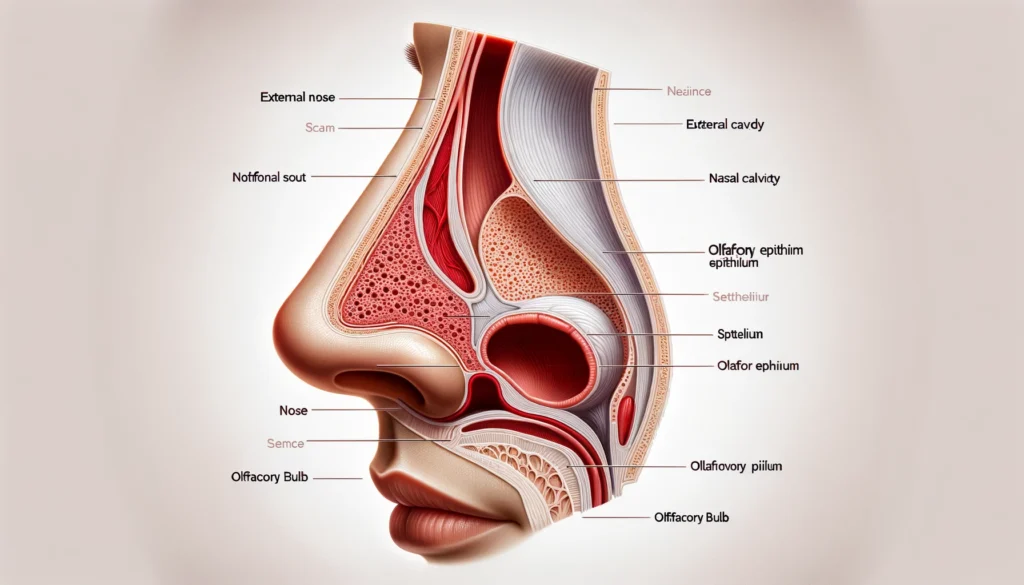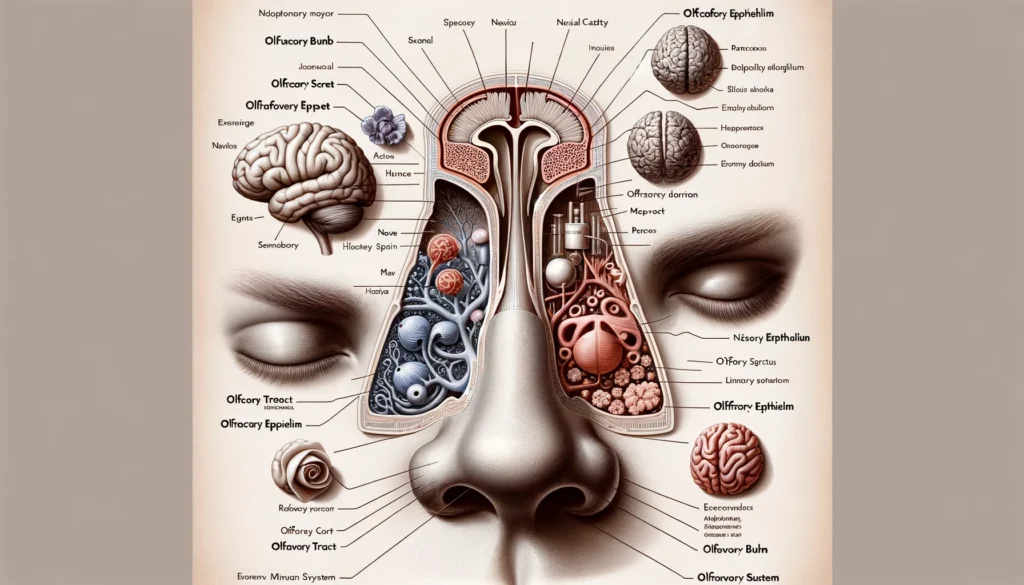
The Secrets of Smell: How Our Noses Shape Our World

Introduction: The Fascinating World of Smell
Smell is a powerful and often underestimated sense. It plays a crucial role in our lives, influencing emotions, memories, and even survival. This article explores the mechanics of how we smell, the anatomy of the nose, the journey of odor molecules, and what makes a smell pleasant or unpleasant.
The Anatomy of the Nose: More Than Meets the Eye

The nose is a complex organ, vital for detecting odors. Inside, the nasal cavity is lined with a mucous membrane that helps trap odor molecules. At the top of the nasal cavity lies the olfactory epithelium, a specialized tissue packed with olfactory receptors. These receptors are the key players in the scent detection process.
The Process of Smelling: From Molecule to Perception
Smelling begins when odor molecules enter the nose with each breath. These molecules dissolve in the mucus lining the nasal cavity and bind to olfactory receptors on the olfactory epithelium. Each receptor is sensitive to specific molecules, triggering a unique signal sent to the brain.
The Relationship Between Tasting and Smelling: A Symbiotic Sensory Experience
Introduction
Taste and smell are two senses that are closely intertwined, working together to create the full experience of flavor. This symbiotic relationship is essential for accurately perceiving the nuances of different foods and beverages. Understanding how these senses interact can provide insights into why they are so interdependent.
The Connection Between Taste and Smell
Shared Pathways
- Both taste and smell rely on chemoreceptors, which detect chemical molecules in the environment. Taste receptors are located on the tongue, while olfactory receptors are found in the nasal cavity.
- These senses share neural pathways that converge in the brain, particularly in areas like the orbitofrontal cortex, which is involved in processing sensory information and integrating it into a unified perception.
Flavor Perception
- Flavor is a combination of taste and smell. When we eat, volatile molecules released from food travel through the back of the throat to the olfactory receptors in the nose, a process known as retronasal olfaction.
- The taste buds on the tongue detect basic tastes (sweet, sour, salty, bitter, and umami), while the olfactory receptors identify the complex aromas. The brain combines these inputs to create the perception of flavor.
Enhancement of Taste by Smell
- Smell significantly enhances the perception of taste. For example, the aroma of a freshly baked apple pie contributes to the sweetness and spiciness experienced when eating it.
- This is why food can taste bland when someone has a cold or a blocked nose; the sense of smell is impaired, and the ability to detect the full flavor profile is reduced.
Why Are Taste and Smell Related?
Evolutionary Advantage
- The close relationship between taste and smell provides an evolutionary advantage. It helps humans detect and identify food, assess its safety, and determine its nutritional value.
- This sensory combination also aids in detecting spoiled or toxic food, which often has a distinctive smell, helping to prevent ingestion of harmful substances.
Emotional and Memory Connections
- Both taste and smell are linked to the limbic system, the part of the brain involved in emotion and memory. This connection explains why certain foods can evoke strong emotional responses or memories.
- The interplay of taste and smell can create powerful associations, making the experience of eating not just a physical sensation but also an emotional and nostalgic one.
The Journey of an Odor Molecule: A Fascinating Path

Odor molecules travel through the air, entering our nose with every breath. Once inside, they dissolve in the nasal mucus and interact with olfactory receptors. The journey of these molecules determines the strength and quality of the scent we perceive, influenced by their chemical properties.
What Makes a Smell Pleasant or Unpleasant?
The perception of smells as pleasant or unpleasant is subjective and influenced by personal experiences and cultural backgrounds. Pleasant smells often come from flowers, food, or other enjoyable sources, while unpleasant smells can signal danger or decay, serving as a protective mechanism.
The Role of Memory and Emotion in Smell
Smell is closely linked to memory and emotion, more so than any other sense. This connection occurs because the olfactory system is directly linked to the brain’s limbic system, responsible for emotion and memory. A familiar scent can evoke vivid memories and strong emotional responses.
The Protective Role of Unpleasant Smells
Unpleasant smells often serve as warnings. They can indicate spoiled food, toxic substances, or danger, helping us avoid harm. This evolutionary trait has been crucial for survival, ensuring that we steer clear of potentially hazardous environments or substances.
The Complexity of Olfactory Detection
Detecting and interpreting smells is a complex process involving multiple brain regions. The olfactory bulbs, located just above the nasal cavity, play a crucial role. They sort and interpret the signals from olfactory receptors, sending the information to higher brain regions for further processing.
Disorders of Smell: Impact on Quality of Life
Disorders like anosmia (loss of smell) can significantly impact a person’s quality of life. These conditions can affect appetite, safety, and emotional well-being. Causes range from nasal blockages and infections to neurological diseases and genetic disorders.
Technological Advances in Olfaction Research
Recent advances in technology have deepened our understanding of olfaction. Imaging techniques and genetic research have provided insights into how olfactory receptors function and are distributed throughout the nasal cavity, paving the way for new treatments for smell disorders.
The Future of Digital Olfaction: Can We Transmit Smells Through Wires?
Transferring smell through wires, akin to how we transmit sound or images, is not currently possible with existing technology. Smell is a chemical sense, meaning it relies on the detection of chemical molecules. Unlike electrical signals or light waves that can be easily digitized and transmitted through wires, smells involve complex chemical interactions that are not yet fully replicable in a digital format.
However, there are ongoing research and developments in the field of digital olfaction, which aims to create devices that can electronically detect and reproduce smells. These technologies typically involve:
- Electronic Noses (e-noses): Devices equipped with sensors that can detect specific chemical compounds in the air. These sensors mimic the biological olfactory system and can identify various odors.
- Scent Delivery Systems: Devices that can release pre-stored scents based on digital signals. These systems often use small cartridges filled with odorant chemicals that can be vaporized and released into the air.
- Digital Olfaction Technology: Research in this area focuses on creating a digital representation of smells that can be transmitted and then reproduced by a receiving device. This involves complex encoding and decoding processes, akin to how sound and images are transmitted.
While the concept is fascinating and holds potential for various applications, such as enhancing virtual reality experiences or improving remote diagnostics, it is still in the experimental stages. The main challenges include accurately capturing and reproducing the vast array of scents that humans can detect and ensuring that the technology is safe and practical for everyday use.
For now, the transmission of smell through wires remains a concept more rooted in science fiction than practical reality. However, continued advancements in sensory technology could bring us closer to making it a reality in the future.
Environmental Factors Affecting Smell
Our sense of smell can be influenced by environmental factors. Pollution, for instance, can impair olfactory function. Weather changes can also alter how odors are perceived. Understanding these influences can help us adapt and maintain our olfactory health.
Enhancing Your Sense of Smell: Practical Tips
Maintaining a good sense of smell involves simple daily practices. Staying hydrated, avoiding pollutants, and engaging in olfactory training exercises can enhance your olfactory sensitivity. These practices can improve your overall sensory experience and quality of life.
The Cultural Significance of Smell
Cultural differences play a significant role in what smells are considered pleasant or offensive. These preferences influence everything from cuisine to personal care products. Understanding these cultural variations can enhance our appreciation of the diversity in human olfactory experiences.
The Future of Smell Research
Research in olfaction is continuously evolving. New discoveries promise to improve diagnostic and treatment methods for smell disorders. Additionally, advances in creating artificial scent environments can enhance various experiences, from dining to virtual reality.
Conclusion: Embracing the Power of Smell
Understanding the sense of smell enhances our appreciation of its role in our lives. By exploring how this complex sense works, we can harness its power to improve health, safety, and quality of life. As research progresses, the potential to enhance our sensory experiences and deepen our connection to the world around us continues to grow.
The relationship between tasting and smelling is a perfect example of how our senses work together to create a richer and more comprehensive perception of the world. This interplay is crucial for enjoying food, detecting danger, and forming lasting memories. Understanding this relationship highlights the importance of both senses in our daily lives and their profound impact on our overall sensory experience.
By following these guidelines, this article aims to provide a comprehensive, engaging, and SEO-friendly exploration of the fascinating world of smell.
Read Also: Solar Eclipses: All what you need to know




1 thought on “The Secrets of Smell: How Our Noses Shape Our World”